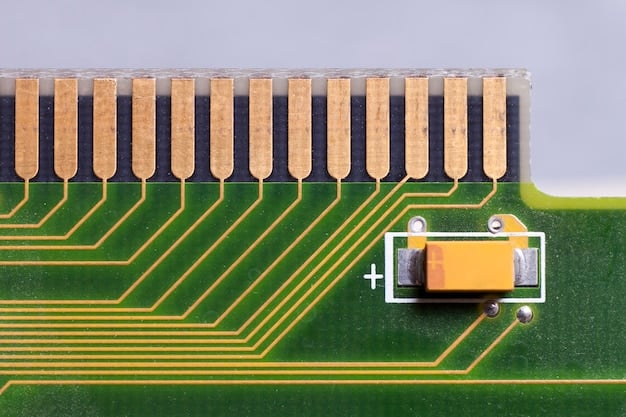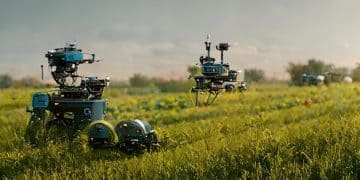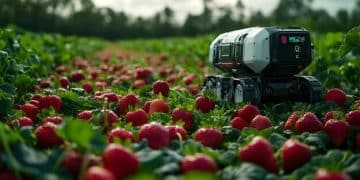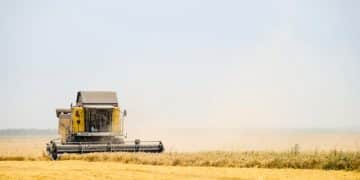Automated Harvesting Systems: A Guide for Small Farms

Automated harvesting systems offer small farms a pathway to increased efficiency, reduced labor costs, and improved crop yields through strategic planning and technology implementation.
The integration of automated harvesting systems: a step-by-step implementation plan for small farms, once considered a futuristic concept, is increasingly becoming a practical solution for small farms seeking to optimize their operations. These systems promise a revolution in agricultural practices, addressing key challenges such as labor shortages and the need for enhanced efficiency.
Understanding Automated Harvesting Systems
Automated harvesting systems represent a significant leap in agricultural technology, designed to autonomously perform tasks traditionally done by human labor. These systems leverage robotics, sensors, and artificial intelligence to identify, select, and harvest crops with greater precision and speed.
For small farms, implementing these technologies can seem daunting, but understanding the core components and benefits is the first step towards successful integration. This section aims to breakdown the complexities and show how automated harvesting can be realistically achieved.
The Core Components
Automated harvesting systems typically consist of several key components working in concert:
- Robotic Harvesters: These are the physical robots equipped with specialized tools for picking, cutting, or collecting crops.
- Sensor Systems: They use cameras, LiDAR, and other sensors to identify ripe crops, assess their quality, and navigate the field.
- Navigation Systems: GPS and computer vision guide the robots through the farm, avoiding obstacles and following predetermined paths.
- Data Management: Software that collects and analyzes data, providing insights on harvest yields, crop health, and system performance.
These components integrate to create a system capable of operating with minimal human intervention, especially beneficial during peak harvesting seasons.

Benefits for Small Farms
The advantages of automated harvesting systems extend beyond mere labor replacement.
- Increased Efficiency: Robots can work longer hours and at a faster pace than humans, leading to higher overall productivity.
- Reduced Labor Costs: By automating harvesting, farms can significantly reduce their reliance on seasonal labor, cutting down operational expenses.
- Improved Crop Quality: Precise harvesting techniques minimize damage to crops, resulting in higher quality produce and reduced waste.
- Data-Driven Insights: The data collected by these systems can inform better crop management decisions, leading to improved yields and resource utilization.
The potential for enhanced profitability from automated harvesting systems makes them a compelling investment for forward-thinking small farms.
In conclusion, understanding the functionality and benefits of automated harvesting systems is critical for small farms considering their adoption. By focusing on key components and the specific advantages they bring, farms can better evaluate the feasibility and potential impact of these technologies on their operations.
Assessing Farm Readiness
Prior to investing in automated harvesting systems, small farms must conduct a thorough assessment of their readiness. This involves evaluating several factors to ensure the successful integration of technology with existing infrastructure and practices.
This assessment will highlight potential challenges and opportunities, paving the way for a customized implementation plan. A realistic self-assessment is key to preventing budget overruns and operational inefficiencies.
Evaluating Crop Suitability
Not all crops are equally suited to automated harvesting. Consider the following:
- Crop Type: Some crops, like strawberries and tomatoes, have well-developed harvesting robots, while others may require customized solutions.
- Planting Density: Automated systems work best with uniform planting patterns and row spacing.
- Maturity Consistency: Crops that ripen uniformly are easier to harvest automatically.
Understanding these nuances helps determine the best system for your specific crops and growing environment.
Infrastructure Evaluation
Your farm’s existing infrastructure plays a crucial role in supporting automated harvesting:
- Field Accessibility: Ensure the robots can navigate the fields without getting stuck or damaged.
- Power Supply: Automated systems may require access to reliable power sources for charging or operation.
- Data Connectivity: A stable internet connection is necessary for data transmission and remote monitoring.
Upgrading or modifying infrastructure might be necessary to accommodate the new technology, so plan accordingly.

Financial Planning
Implementing automated harvesting systems requires a significant financial commitment. Consider the following financial factors:
- Initial Investment: The cost of purchasing and installing the system, including robots, sensors, and software.
- Operational Costs: Ongoing expenses such as maintenance, repairs, energy consumption, and software updates.
- Return on Investment (ROI): Calculate the payback period and potential profitability based on projected increases in efficiency and reduced labor costs.
A detailed financial plan will help you secure funding and manage your resources effectively.
In conclusion, assessing farm readiness is a critical step in the implementation of automated harvesting systems. By thoroughly evaluating crop suitability, infrastructure, and financial considerations, small farms can make informed decisions and prepare for a successful transition to automated operations.
Selecting the Right System
Choosing the appropriate automated harvesting system is a pivotal decision that should align with the specific needs and resources of your small farm. This selection process requires a detailed understanding of available technologies, vendors, and customization options.
Properly researching and comparing different systems ensures that the chosen solution can effectively address your unique challenges and goals. The right system can optimize your harvest process, while the wrong one can lead to inefficiencies and financial losses.
Identifying Needs
Begin by clearly defining your harvesting needs:
- Harvest Volume: How much of your crop needs to be harvested on a daily or weekly basis?
- Harvest Window: How long is the optimal harvesting period for your crops?
- Labor Availability: How much are you currently relying on manual labor, and what are the associated costs?
These factors will help you determine the scale and type of automation required.
Exploring Available Technologies
Familiarize yourself with the range of automated harvesting technologies:
- Robotic Arms: Suitable for delicate crops that require precise handling.
- Autonomous Vehicles: Designed for large-scale harvesting of row crops like grains and vegetables.
- Hybrid Systems: Combine robotic arms with autonomous navigation for versatile harvesting solutions.
Consider the pros and cons of each technology in relation to your specific crops and farming practices.
Evaluating Vendors
Choosing a reliable vendor is essential for the long-term success of your automated harvesting system:
- Reputation: Research the vendor’s track record, customer reviews, and industry recognition.
- Support Services: Ensure the vendor offers comprehensive training, maintenance, and technical support.
- Customization Options: Can the vendor tailor the system to meet your specific needs and integrate with your existing infrastructure?
Selecting a vendor that offers robust support and customization can significantly enhance your implementation process and overall satisfaction.
In conclusion, selecting the right automated harvesting system involves carefully identifying your needs, exploring available technologies, and evaluating potential vendors. By thoroughly assessing these factors, small farms can make informed decisions and invest in a system that truly optimizes their harvesting operations.
Phased Implementation Strategy
Implementing automated harvesting systems can be a complex undertaking, especially for small farms with limited resources. A phased implementation strategy allows farms to gradually integrate technology, minimizing disruption and maximizing learning opportunities.
This approach involves breaking down the implementation process into smaller, manageable stages, each with specific goals and timelines. By starting small and scaling up, farms can refine their processes, improve efficiency, and build confidence in their automated systems.
Pilot Project
Begin with a small-scale pilot project:
- Select a Limited Area: Choose a small section of your farm for initial testing.
- Focus on a Single Crop: Start with one crop that is well-suited to automation.
- Gather Data: Collect data on harvesting efficiency, crop quality, and labor savings.
A pilot project allows you to test the system in a controlled environment and identify any potential issues before full-scale deployment.
Incremental Expansion
Gradually expand the system’s coverage:
- Add More Areas: Increase the area covered by the automated system in stages.
- Incorporate Additional Crops: Introduce automation to other crops as you gain experience and confidence.
- Optimize System Settings: Continuously fine-tune the system’s parameters to improve performance and efficiency.
Incremental expansion allows you to adapt the system to different areas and crops, optimizing its performance over time.
Employee Training
Provide comprehensive training to your employees:
- Operation and Maintenance: Train employees on how to operate, maintain, and troubleshoot the automated system.
- Data Analysis: Teach employees how to interpret the data collected by the system and use it to make informed decisions.
- Safety Procedures: Ensure employees understand and follow all safety procedures when working with automated equipment.
Well-trained employees are essential for maximizing the benefits of automated harvesting systems.
In conclusion, a phased implementation strategy is a pragmatic approach for small farms looking to adopt automated harvesting systems. By starting with a pilot project, gradually expanding the system, and providing thorough employee training, farms can minimize disruption, optimize performance, and achieve long-term success.
Data Management and Analytics
Effective data management and analytics are critical components of successful automated harvesting systems. These elements enable farmers to gain valuable insights into their operations, optimize performance, and make informed decisions.
By collecting, analyzing, and interpreting data from automated systems, farms can identify areas for improvement, reduce waste, and increase overall efficiency. A well-structured data management strategy transforms raw data into actionable intelligence.
Data Collection
Automated harvesting systems generate vast amounts of data. Key data points to collect include:
- Harvest Yield: The quantity of crops harvested by the system.
- Crop Quality: Data on crop size, color, and other quality metrics.
- System Performance: Information on robot uptime, speed, and efficiency.
Collecting comprehensive data is the foundation for effective analysis and decision-making.
Data Analysis Tools
Utilize data analysis tools to gain insights from the collected data:
- Data Visualization: Use charts, graphs, and other visualizations to identify trends and patterns.
- Statistical Analysis: Apply statistical techniques to analyze data and identify significant correlations.
- Machine Learning: Employ machine learning algorithms to predict future performance and optimize system settings.
These tools help you transform raw data into actionable intelligence.
Decision-Making
Use data-driven insights to make informed decisions:
- Crop Management: Adjust planting, irrigation, and fertilization practices based on harvest data.
- System Optimization: Fine-tune system settings to improve efficiency and reduce downtime.
- Resource Allocation: Allocate resources more effectively based on data-driven insights.
Data-driven decision-making leads to improved performance and profitability.
In conclusion, data management and analytics are essential components of automated harvesting systems. By collecting comprehensive data, utilizing appropriate analysis tools, and making data-driven decisions, farms can optimize their operations, reduce waste, and increase overall efficiency.
Addressing Challenges and Future Trends
Implementing automated harvesting systems comes with its own set of challenges, ranging from technological limitations to economic considerations. Understanding these challenges and staying informed about future trends can help small farms navigate the evolving landscape of agricultural technology.
By addressing current obstacles and anticipating future advancements, farms can position themselves for long-term success in the age of automation. This proactive approach ensures that farms remain competitive and resilient in the face of change.
Technological Challenges
Be aware of the technological limitations of automated harvesting systems:
- Crop Variability: Systems may struggle with crops that vary in size, shape, or ripeness.
- Environmental Conditions: Weather conditions like rain, wind, and extreme temperatures can impact system performance.
- Maintenance Requirements: Automated systems require regular maintenance and repairs.
Addressing these challenges often requires ongoing research and development efforts.
Economic Considerations
Carefully consider the economic implications of automation:
- High Initial Investment: The cost of purchasing and installing an automated system can be substantial.
- Operational Costs: Ongoing expenses such as maintenance, energy consumption, and software updates.
- Labor Displacement: Automation may lead to the displacement of human labor.
Balancing these costs and benefits is crucial for long-term sustainability.
Future Trends
Stay informed about emerging trends in automated harvesting:
- AI and Machine Learning: Advancements in AI and machine learning will enable systems to adapt to changing conditions and optimize performance.
- Sensor Technology: Improved sensor technology will provide more accurate and detailed data on crop health and quality.
- Integration with IoT: Integration with the Internet of Things (IoT) will enable seamless communication between different farm systems.
These advancements promise to make automated harvesting systems more efficient, reliable, and cost-effective.
In conclusion, addressing challenges and staying informed about future trends are essential for the successful implementation of automated harvesting systems. By understanding the limitations of current technology, carefully considering economic implications, and anticipating future advancements, small farms can position themselves for long-term success in the age of automation.
| Key Point | Brief Description |
|---|---|
| 🌱 Assessing Farm Readiness | Evaluating crop suitability, infrastructure, and finances before implementing systems. |
| 🤖 Selecting Right System | Choosing a system aligned with needs, exploring tech, and evaluating vendors. |
| 📊 Data Management | Collecting, analyzing data for informed decisions and performance optimization. |
| 📈 Phased Implementation | Starting small, expanding gradually, with employee training for success. |
FAQ
▼
Automated harvesting offers increased efficiency, reduced labor costs, improved crop quality, and data-driven insights for better farm management.
▼
Evaluate your crop suitability, infrastructure, and financial readiness to determine if your farm can support automated harvesting systems effectively.
▼
Crops like strawberries and tomatoes, which have well-developed harvesting robots and uniform ripening, are ideal for automation.
▼
Identify your specific needs, explore available technologies, and evaluate vendors based on reputation, support, and customization options.
▼
Collecting and analyzing data can provide insights into crop health, system performance, and resource allocation, optimizing overall harvesting efficiency.
Conclusion
Implementing automated harvesting systems: a step-by-step implementation plan for small farms represents a significant opportunity for small farms to enhance their efficiency, reduce labor costs, and improve crop yields. By carefully assessing their readiness, selecting the right system, and adopting a phased implementation strategy, farms can overcome the challenges and reap the rewards of agricultural automation. The future of farming is here, and automated harvesting systems are leading the way.





